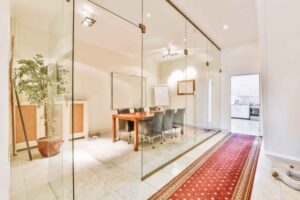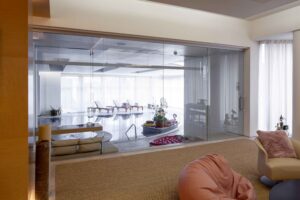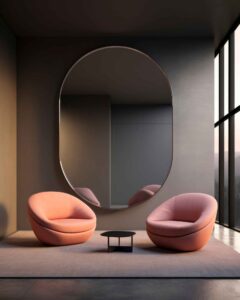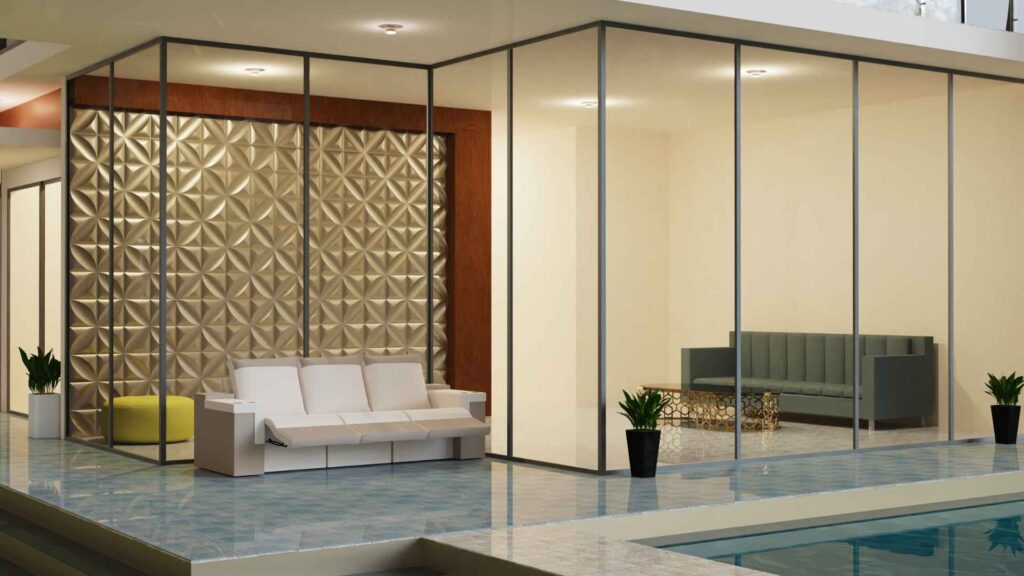Glass has become the cornerstone of modern interior design and offers endless possibilities for transforming spaces with its versatility, elegance and functionality. Its unique properties allow it to adapt to a variety of styles, from minimalist to luxurious, making it a popular choice for architects and designers. Let’s delve into how glass has redefined contemporary interiors and its significant role in creating sophisticated living and working environments.
1. Maximizing natural light
One of the most desired elements in modern interiors is an abundance of natural light, and glass plays a key role in achieving this goal. Large glass windows, skylights and glass doors allow sunlight to flood the spaces, creating a warm and welcoming atmosphere.
Incorporating glass into interior design not only reduces reliance on artificial lighting, but also improves the overall mood and productivity of residents. By letting light through, glass helps create brighter, livelier spaces that feel open and connected.

Read more Top Glass Design Trends for Modern Homes and Offices in 2024
2. Improvement of visual space
Glass is a material that can optically expand even the smallest rooms. Glass partitions, sliding doors and wall panels remove physical barriers and create a sense of openness while maintaining functionality.
Clear glass panels are particularly effective in creating larger interiors, ideal for townhouses and offices where space is at a premium. Frosted or textured glass can achieve the same effect while adding privacy and striking a balance between openness and closure.
3. Versatile applications
The versatility of glass in interior design is unmatched. It can be used in:
- Partitions and Partitions: Seamlessly segment spaces while maintaining flow.
- Furniture: Glass tables, cabinets and shelves for a modern look.
- Balustrades and Railings: Clear glass for unobstructed safety.
- Doors and Windows: Improved transparency and light.
- Decorative features: Stained glass, frosted or etched glass for artistic accents.

This adaptability allows designers to use glass in countless ways, combining aesthetics with functionality.
4. Adding elegance with reflective surfaces
Glass is synonymous with sophistication. Reflective surfaces such as mirrors and high-gloss surfaces add depth and luxury to interiors. Mirrored walls, for example, create a sense of grandeur while doubling as design elements.
When used strategically, glass can elevate the overall ambiance of a room, giving it a sleeker and more refined feel. The reflective properties of the glass also amplify the light and further increase the brightness and openness of the space.
5. Bridging indoor and outdoor spaces
Modern design often emphasizes the connection with nature, and glass is a tool to achieve this harmony. Floor-to-ceiling glass windows and sliding glass doors create seamless transitions between indoor and outdoor spaces and promote a sense of unity.
This approach not only provides stunning views, but also promotes natural ventilation and brings in the outdoors. Glass walls and enclosures for terraces, balconies or gardens are increasingly popular in homes and commercial spaces.
6. Promoting sustainability
Glass in interior design also promotes sustainability. It is recyclable and has a long life and is in line with ecological design principles. Energy-efficient options such as double glazing or Low-E glass improve insulation and reduce energy consumption for heating and cooling.
By supporting sustainable practices, glass helps create environmentally friendly interiors that prioritize energy efficiency without compromising on style.
7. Merging technology with design
Technology has turned glass into a dynamic design element. Smart glass, which changes from transparent to opaque at the push of a button, is a fundamental change in interior design. It provides privacy on demand, eliminates the need for curtains or blinds and adds a futuristic touch.
Interactive glass surfaces, used in smart homes and offices glass, integrate touch controls and displays, seamlessly blending technology with aesthetics.

8. Offer customization and creativity
One of the most interesting aspects of glass in interior design is its potential for customization. From complex etchings to bold colors and textures, glass can be tailored to specific design visions.
Designers often use decorative glass to add character and individuality to spaces. Whether it’s a custom glass screen in the kitchen glass or an elegant wall in the living room, these unique elements make interiors feel special and different.
Read more on Top 10 Shower Enclosure Designs to Upgrade Your Bathroom in 2024
Transform your interiors with Crystal Casa
Glass is not just a material; it is a transformative design element that defines the essence of modern interiors. Its ability to increase light, expand space and add elegance makes it indispensable in creating sophisticated and functional environments.
Crystal Casa specializes in creating innovative glass solutions that align with your design aspirations. From custom glass installations to sustainable and technologically integrated designs, we bring expertise and creativity to every project. Elevate your interiors with the timeless beauty of glass. Contact Crystal Casa today to explore how we can redefine your spaces with cutting-edge glass designs.


